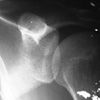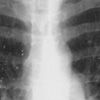- Clinical Technology
- Adult Immunization
- Hepatology
- Pediatric Immunization
- Screening
- Psychiatry
- Allergy
- Women's Health
- Cardiology
- Pediatrics
- Dermatology
- Endocrinology
- Pain Management
- Gastroenterology
- Infectious Disease
- Obesity Medicine
- Rheumatology
- Nephrology
- Neurology
- Pulmonology
Man With Painful Shoulder Abscess
For 2 weeks, a 31-year-old man has had a nonhealing, painful abscess on his left shoulder. A week before presentation, he sought treatment at a walk-in clinic; the abscess was incised and drained, and he was given gatifloxacin.

Figure 1

Figure 2
For 2 weeks, a 31-year-old man has had a nonhealing, painful abscess on his left shoulder. A week before presentation, he sought treatment at a walk-in clinic; the abscess was incised and drained, and he was given gatifloxacin. His symptoms worsened despite treatment. He has also had tactile fevers, dyspnea, chest discomfort, and nausea for the past 2 weeks but no vomiting, diarrhea, weight loss, or cough. He denies trauma to the area.
The patient is training to be a medical assistant. He smokes cigarettes but denies drug or ethanol use. His medical history is unremarkable.
The left shoulder is tender with erythema and induration; there is an underlying colored tattoo (obtained 2 years earlier) and a central 2-cm linear incision site draining serosanguineous fluid. Mild ipsilateral axillary lymphadenopathy and painful passive range of motion of the shoulder are noted. Sensory and motor function of the limb appears intact. The remaining physical findings are normal.
Incision and drainage of the abscess reveals blood and small silver droplets of fluid; however, there is no pus pocket. Results of a complete blood cell count, basic metabolic panel, drug screen, and urinalysis are normal. The shoulder radiograph is shown.
What is the most likely cause of the abnormality on this film-and what further action is warranted?
(Answer on the next page.)

Figure 1

Figure 2
Mercury poisoning
The shoulder radiograph showed a pattern of scattered radio-opacification suggestive of heavy metal exposure (A). The patient's blood mercury level measured 267 µg/L (normal, less than 10 µg/L). A chest radiograph revealed mercury scattered throughout the lungs and filling the appendix (B).
On further questioning, the patient stated that he had found an old mercury thermometer in the nursing home where he works. He also had recently learned how to give needle injections but would not comment on whether he had injected himself. He admitted that he had been depressed recently. He was taking sertraline but discontinued it because of GI symptoms.
Mercury toxicity causes acrodynia. It is also commonly associated with irritability, insomnia, anorexia, diaphoresis, photophobia, and rash.
The first step in the management of mercury poisoning is to contact the local poison control center. A chelating agent is used to help detoxify the blood: dimercaprol and d-penicillamine are older agents; succimer and 2,3-dimercapto-1-propanesulfonic acid (DMPS) are newer water-soluble chelators. All chelators have sulfhydryl groups that bind mercury. The duration of therapy is guided by blood and urine levels of mercury.
This patient did not require isolation; however, contaminated materials (feces) were double wrapped in biohazard bags and required special disposal. He was treated with succimer and underwent a mandatory 72-hour psychiatric evaluation. He met the Diagnostic and Statistical Manual of Mental Disorders, Fourth Edition criteria for major depression, and a regimen of venlafaxine and risperidone was started. He was also given clindamycin for a suspected secondary skin infection. His hospital course was uneventful, and he remained hemodynamically stable.
In cases such as this one, in which the symptoms do not fit any known pattern of disease or injury, consider the possibility of self-harm.
